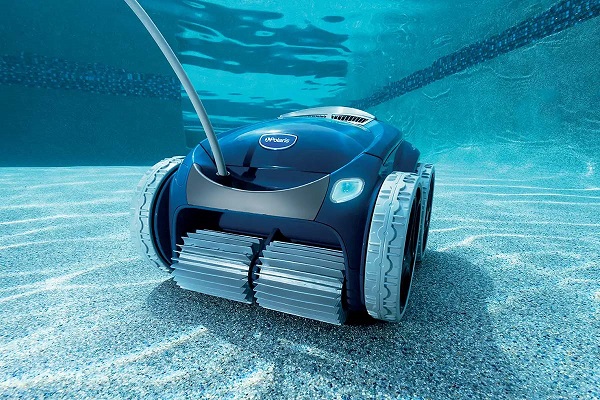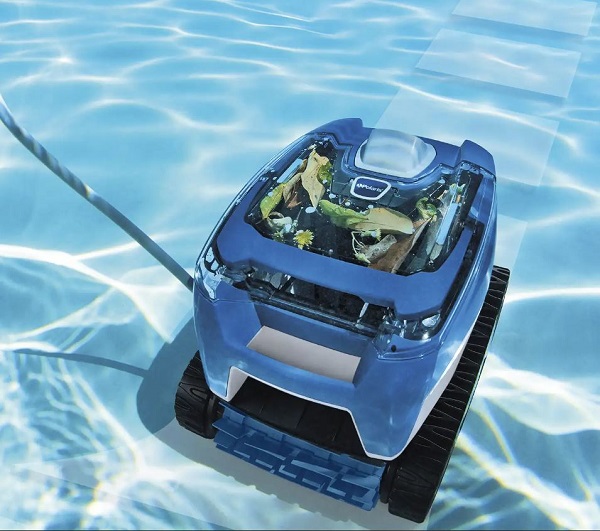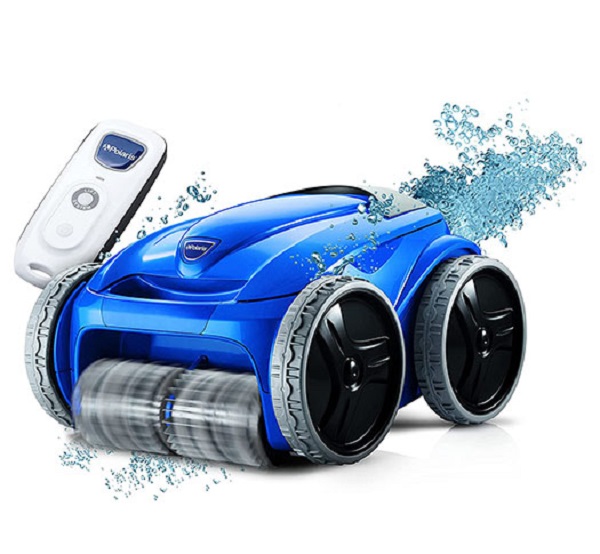Polaris pool cleaners are a popular choice for homeowners looking for a reliable and efficient way to keep their pools clean. These robotic cleaners use a combination of suction and pressure to navigate the pool and remove debris.
Why choose a Polaris automatic pool cleaner?
Polaris automatic pool cleaners are a popular choice for pool owners seeking a convenient and effective cleaning solution.

Comparing Polaris models: 280 vs 380 vs robotic cleaners
| Feature | Polaris 280 | Polaris 380 | Polaris Robotic Cleaners |
| Type | Pressure-side automatic cleaners. | Pressure-side automatic cleaners. | Operate independently, equipped with their own motors and filtration systems |
| Power Source | Rely on the water pressure from your pool’s pump to move around and clean. | Rely on the water pressure from your pool’s pump to move around and clean. | Navigating your pool for hands-free cleaning. |
| Pool Size | Suitable for smaller pools (up to 40 ft.) | Ideal for medium-sized pools (up to 50 ft.) | Suitable for different pool sizes |
| Suitability | Basic cleaning needs. | More powerful cleaning with features like a booster pump (on some models) . | Handling larger pools than the pressure-side cleaners. |
| Surface cleaning | Good cleaning for floors, walls, and the waterline (on some models).Struggle with steeper inclines or very complex pool shapes. | Potentially provide more thorough coverageBetter suited for uneven surfaces or complex pool shapes. | |
| Cost | The most affordable option. | Slightly higher price tag than the 280. | The most expensive option, and might have higher upfront costs. |
| Maintenance and upkeep | Require less maintenance compared to robotic cleaners. | Require more upkeep, such as emptying filter bags or cartridges, cleaning sensors for proper navigation… | |
The benefits of choosing an automatic pool cleaner for your swimming pool
- Convenience: They operate independently, minimizing the need for manual cleaning.
- Efficiency: Polaris cleaners utilize pressure or suction power to clean floors, walls, and sometimes the waterline (depending on the model).
- Variety of Options: Polaris offers a range of cleaners to suit different pool sizes, shapes, and budgets.
- Durability: They are known for their robust construction and reliable performance.
How do Polaris pool cleaners leverage jet propulsion for superior cleaning?
A key advantage of Polaris pressure-side cleaners is their jet propulsion system. This system utilizes a stream of water pumped from your pool’s filtration system to propel the cleaner around the pool. This design offers several benefits:
- Powerful Cleaning: The jet propulsion system provides strong suction power for effective debris removal from floors, walls, and the waterline (on some models).
- Maneuverability: The water jets allow the cleaner to navigate different pool surfaces and obstacles efficiently.
- Energy Efficiency: Since they leverage your existing pool’s pump pressure, Polaris pressure-side cleaners can be more energy-efficient compared to some robotic cleaners that use their own motors.
Finding the right Polaris pool cleaner for your in-ground pool
Finding the right Polaris pool cleaner for your in-ground pool involves considering factors such as pool size, type, and cleaning requirements.

Determining the best model for your pool size and type
Assess the size and shape of your in-ground pool to determine the appropriate cleaning coverage required.
Consider factors such as pool surface type (concrete, vinyl, fiberglass, or tile), length, width, depth, and any special features like steps or irregular shapes.
Understanding the importance of a booster pump with Polaris pressure-side cleaners
Polaris pressure-side cleaners typically require a booster pump to operate effectively, providing additional water pressure and propulsion for enhanced cleaning performance.
If you choose a Polaris pressure-side cleaner, ensure that your pool is equipped with a compatible booster pump or be prepared to install one.
Polaris robotic vs pressure-side vs suction: Which is best for you?
Polaris Robotic Cleaners: These cleaners operate independently of your pool’s filtration system and do not require a booster pump. They offer advanced cleaning features such as programmable cleaning cycles, onboard filtration, and smart navigation technology. They are ideal for larger pools and owners seeking maximum convenience and efficiency.
Polaris Pressure-Side Cleaners: These cleaners use water pressure from a booster pump to propel the cleaner around the pool and collect debris in a filter bag. They offer powerful cleaning performance and are suitable for pools of various sizes and shapes. However, they require a booster pump for operation.
Polaris Suction-Side Cleaners: These cleaners attach to your pool’s existing suction line and use the pool’s filtration system to vacuum debris from the pool surface and walls. They are typically more affordable than robotic and pressure-side cleaners but may have slightly lower cleaning performance. They are suitable for smaller to medium-sized pools with simple shapes.
Maintaining your Polaris pool cleaner for peak performance

Maintenance for Peak Performance:
- Clean your Polaris pool cleaner regularly after each use to remove debris, dirt, and algae buildup. Rinse the cleaner’s components, including the filter bag or cartridges, hoses, and brushes, with clean water.
- Inspect the cleaner’s wheels, tracks, and other components for signs of wear or damage. Replace worn-out parts promptly to prevent further damage and maintain cleaning performance.
- Check the filter bag or cartridges frequently and clean or replace them as needed to prevent clogging and maintain suction efficiency.
- Keep the pool water properly balanced and chemically treated to prevent algae growth and reduce strain on the cleaner’s components.
Troubleshooting common issues: Loss of pressure or malfunction
Loss of Pressure: If your Polaris pool cleaner experiences a loss of pressure, check for clogs or obstructions in the cleaner’s hoses, filter bag, or in the pool’s filtration system. Ensure that the pump and booster pump (if applicable) are operating properly and providing adequate water flow.
Malfunction: If your Polaris cleaner is not moving or operating correctly, check for any damage or wear on the cleaner’s components, such as the wheels, gears, or drive belts. Inspect the hose connections and ensure they are secure. Refer to the user manual or manufacturer’s guidelines for troubleshooting tips specific to your model.
Replacing parts: When and where to buy Polaris cleaner replacement parts
Replace worn-out or damaged parts of your Polaris pool cleaner as needed to maintain optimal performance. Common replacement parts may include wheels, tires, belts, brushes, filter bags, and cartridges.
Purchase genuine Polaris replacement parts from authorized dealers or reputable online retailers to ensure compatibility and quality.
Refer to the user manual or manufacturer’s guidelines for instructions on how to properly replace parts and perform maintenance tasks.
Cleaning and storing your pool cleaner: Best practices
Thoroughly clean and dry your Polaris pool cleaner before storing it for an extended period, such as during the off-season.
Store the cleaner in a cool, dry place away from direct sunlight to prevent damage from UV exposure.
Consider using a cover or storage bag to protect the cleaner from dust, debris, and moisture during storage.
Maximizing cleaning efficiency with Polaris pool cleaners

The role of filter bags and proper filtration in pool cleanliness
Filter bags play a crucial role in capturing and containing debris and contaminants removed from the pool by the Polaris cleaner.
Ensure that the filter bag is clean and free of debris before each use to maximize suction efficiency and cleaning performance.
Regularly clean or replace the filter bag as needed to prevent clogs and maintain optimal filtration.
Adjusting your Polaris cleaner settings for optimal cleaning performance
Polaris pool cleaners often come with adjustable settings or features that allow you to customize cleaning cycles and performance according to your pool’s needs.
Adjust the cleaning cycle duration, speed, or pattern to optimize cleaning coverage and efficiency based on your pool size, shape, and cleaning requirements.
Experiment with different settings to find the configuration that delivers the best results for your pool.
Innovative features of the Polaris 3900 Sport and other models for enhanced cleaning
The Polaris 3900 Sport and other models offer innovative features designed to enhance cleaning performance and efficiency.
These features may include advanced navigation technology for precise cleaning coverage, powerful scrubbing brushes for thorough debris removal, and large-capacity filter bags for extended cleaning cycles.
Look for additional features such as dual jets for enhanced propulsion, four-wheel drive for improved traction and maneuverability, and advanced debris management systems for more efficient debris collection and containment.
Expert and user reviews: What do customers think about Polaris cleaners?
Making an informed decision about a pool cleaner involves understanding not only the technical specifications but also real-world user experiences. Here’s a breakdown of what customers think about Polaris cleaners, helping you gauge their reputation against competitors.

Analyzing customer reviews and ratings: Reliability and effectiveness
Reliability and Effectiveness: Customer reviews often praise Polaris cleaners for their durability and cleaning performance. Users often highlight their effectiveness in tackling leaves, debris, and dirt from pool floors, walls, and sometimes the waterline (depending on the model).
Potential Drawbacks: Some reviews mention challenges with pressure-side cleaners needing sufficient pump pressure to function optimally. Robotic cleaners might at times receive comments about higher upfront costs and the need for occasional maintenance on filter bags, cartridges, and brushes.
Polaris pool cleaners vs other brands: Comparing market feedback
Polaris vs. Pressure-Side Competitors: Users often rank Polaris favorably against other pressure-side cleaners in terms of reputation and cleaning power. However, some competitors might offer more affordable options at the expense of features or performance.
Polaris vs. Robotic Competitors: Customer reviews often show satisfaction with both Polaris and other well-regarded robotic cleaner brands. The choice might come down to specific features, price points, and compatibility with your pool size and shape.
The impact of customer service on user satisfaction and brand loyalty
Positive Customer Service: Prompt and helpful customer service can significantly impact brand perception. Positive reviews mentioning efficient troubleshooting assistance from Polaris can boost customer confidence and brand loyalty.
Importance of Service: Conversely, negative experiences with customer service can deter potential buyers and dissatisfy existing customers. Polaris customer service feedback can be a valuable indicator of their commitment to user satisfaction.
Integrating a Polaris pool cleaner with your existing pool equipment
Integrating a Polaris pool cleaner with your existing pool equipment is relatively straightforward, but it’s essential to ensure compatibility with your pool’s filtration system and sanitizer for optimal performance.

Compatibility with various types of pool filtration systems
Polaris pool cleaners are compatible with various types of pool filtration systems, including sand filters, cartridge filters, and DE (diatomaceous earth) filters.
Before purchasing a Polaris cleaner, check the manufacturer’s specifications and compatibility requirements to ensure it will work effectively with your pool’s filtration system.
Ensure that your pool pump is in good working condition and provides sufficient water flow and pressure to operate the Polaris cleaner efficiently.
Setting up your Polaris cleaner: Step-by-step guide
The specific setup steps might vary slightly depending on your Polaris cleaner model. However, here’s a general guideline:
- Consult Your Manual: Always refer to the instruction manual provided with your specific Polaris cleaner model. It will contain detailed setup instructions unique to your unit.
- Assemble the cleaner (if necessary): Some Polaris models might require minor assembly before use. Follow the manual’s instructions for proper assembly.
- Attach the hose. Connect the hose to the cleaner and your pool’s filtration system (refer to the manual for specific connection points based on your model, pressure-side, or robotic).
- Prime the pump (if applicable): Some pressure-side models might require priming the pump to initiate water flow through the hose. Consult the manual for priming instructions specific to your model.
- Place the Cleaner in the Pool: Carefully place your Polaris cleaner into the pool. Some robotic models might allow for programmable starting locations through their control systems (refer to your model’s manual for details).
Ensuring your pool’s sanitizer works effectively with Polaris cleaners
Polaris pool cleaners do not interfere with most pool sanitizers, including chlorine, bromine, and saltwater systems.
Ensure that your pool’s sanitizer levels are within the recommended range for your specific type of sanitizer and maintain a proper water chemistry balance to ensure effective sanitation.
Monitor sanitizer levels regularly and adjust as needed to ensure the pool water remains clean and safe for swimming.
Overall, Polaris pool cleaners offer a convenient and effective way to keep your pool clean and sparkling. With their powerful suction, rotating brushes, and advanced features, these cleaners are a valuable investment for any pool owner.

Meet David Thomas, a seasoned professional with nearly 8 years of experience specializing in inspecting and resolving issues related to swimming pools. With his expertise and meticulous attention to detail, David ensures the safety and functionality of pools, making them a refreshing oasis for all to enjoy. Whether it’s troubleshooting equipment or maintaining water quality, David’s proficiency guarantees top-notch solutions tailored to meet every pool owner’s needs.
